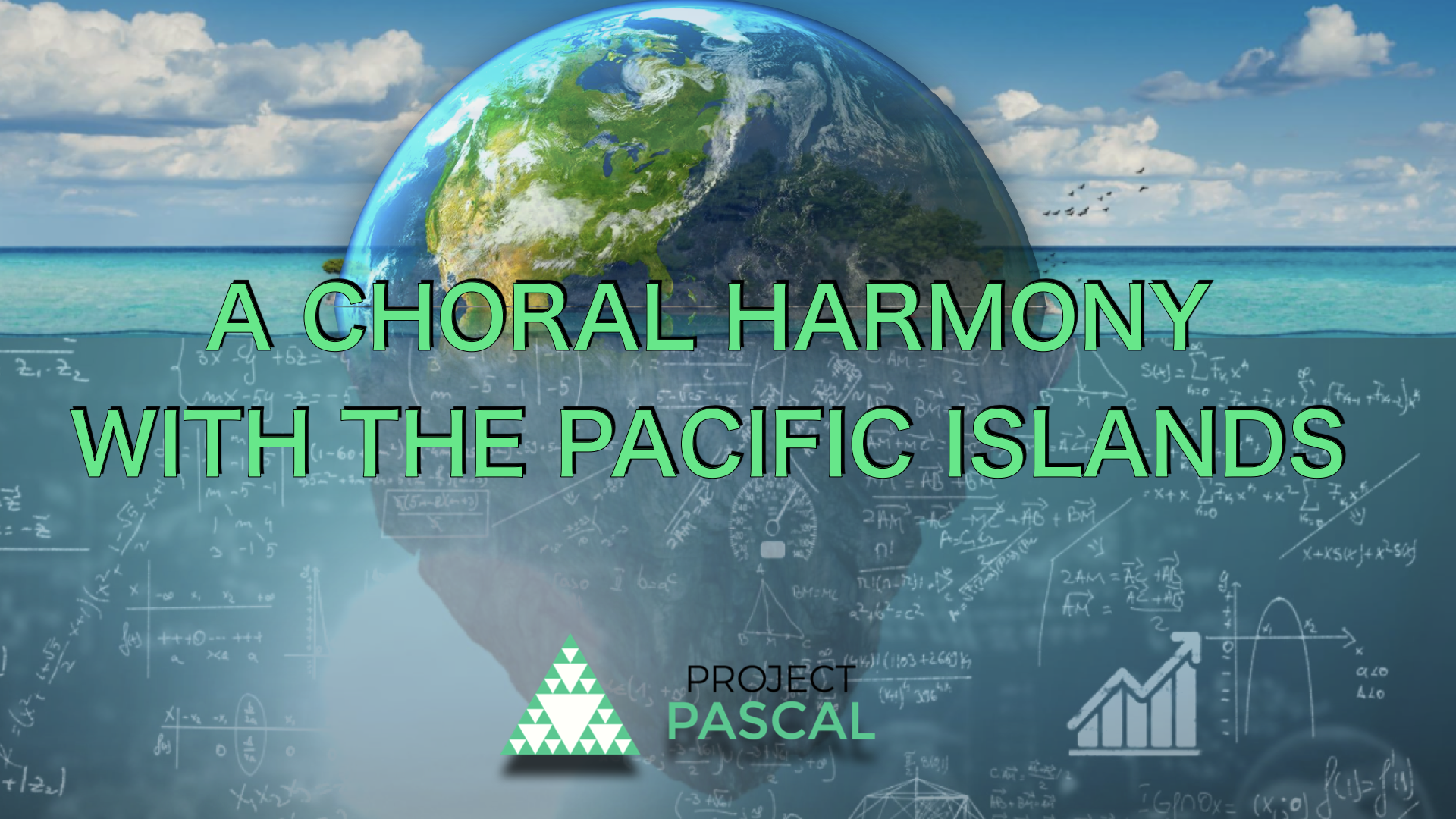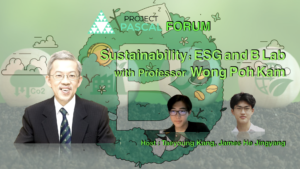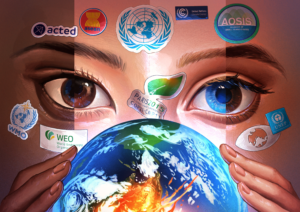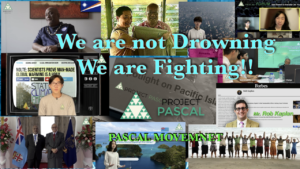Spotlight on Pacific Islands

Spotlight on Pacific Islands
Exploring the Pacific Islands: Battling Climate Change’s Dire Impact by Project Pascal
The Pacific Isles have long grappled with a relentless adversary: the battle of climate change. While this challenge has garnered global attention, its impact on these island states goes beyond the ordinary. As President David Panuelo eloquently expressed during the United Nations General Assembly last year, “For Micronesia, as a Pacific Island Country, traditional security concerns have yielded to a more enduring threat – Climate Change.”
A Panorama of Unique Environments
The Pacific Islands have found themselves at the vanguard of the battle against the pernicious forces of climate change. These islands harbor a profusion of distinct ecosystems and maritime marvels. The azure waters cradle coral reefs, serving as abodes for schools of fish. Secluded seagrass beds serve as pastures for foraging turtles, while labyrinthine mangrove thickets provide sanctuary for diminutive aquatic creatures. Ivory beaches frame the landscape, fringed by the watchful silhouettes of coconut palms. Above, albatrosses soar the cerulean skylines.
There are over 25,000 Pacific Islands which comprise 15% of the Earth’s surface[1]. Despite the small population of 2.3 million people residing in those areas, the region has a colorful cultural tapestry of 1,750 unique languages. Historically, the three main cultural groups of the Pacific Islands — Melanesian, Polynesian, and Micronesian — are heavily reliant on their environment for sustenance and livelihood. Thus, their wisdom and resourcefulness are critical to teaching the world how to conserve ocean resources in the face of its vicissitudes.
The Looming Specter of Climate Change
The Pacific Islands region takes the disproportionate brunt of climate change impacts, as evinced by the unprecedented rise in sea levels which threatens to flood these low-lying island systems with flooding. This has also plagued the region with other severe issues like coastal erosion and storm surges. Furthermore, 90% of the coral reefs in much of the Pacific Island region may suffer severe damage given the drastic rise in temperature, which can destroy ecosystems in the ocean. For coastal communities, climate change may be fatal. High tides can deluge homes, wash out beaches, and destroy infrastructure. Saltwater permeates wetlands, ravaging taro fields and other crop sites. Many of the Pacific nation’s islets are running low on the freshwater necessary to support life. The heat waves, droughts, storms, flooding, and landslides common in Pacific Island nations wreak havoc on marine ecosystems and thus on their livelihoods.
On top of that, climate change has exacerbated the damage done to global communities by existing problems like pandemics, agricultural diseases, aviation and maritime accidents, and marine pollution.
The Compounding Challenges
Micronesia has a tough job ahead. The remote and dispersed nature of its islands across a vast oceanic area complicates disaster relief. It also has one of the highest poverty rates among the Pacific Island countries, with 41% of its population living below the national poverty line. There’s a vicious cycle at play: climate change cuts off many of the income sources common on the islands, like agriculture and fishing, making it even more difficult to mitigate these harms.
A Global Responsibility
The small island states of the Pacific are only responsible for 0.03% of global greenhouse gas emissions, but they are facing the majority of climate change threats head-on.
A Drop in the Ocean
Faced with a problem on such an immense scale, it feels easier to lapse into nihilism. As individuals, there is little we can do to directly decelerate climate change; as students, we have no means to enact policies or reinvent industries. The objective fact that every day of passivity takes a toll on our environment may serve to further demoralise you or to propel you into realistic action. We hope this achieves the latter effect.
The climate despair rhetoric takes for granted that climate efforts are going to be futile; but if we can close the ozone hole[2] with public furor and an international protocol, it is worth our shot to contribute our solutions to the crisis. One person can’t bring the world to net-zero emissions, but we can do our part by studying energy sources, designing sea walls, or spreading stories about a sinking island nation.
For now, we’ve decided to take on the last one. In recent years, public awareness campaigns, especially on social media, have proved effective in gaining traction. Community workshops and school courses disseminate information to the very people who are afflicted, and to those who might be able to alleviate the situation. NGOs work in tandem with governments to ensure no one falls through the cracks.
In many countries, youth are far from powerless. Young advocates organise school rallies, speak to politicians, and find green-tech start-ups. The potential for education and youth engagement is endless.
Making Waves
In Pacific Island nations, where climate change has been a pressing issue for some time, efforts have already been made. Last year, they concluded the Our Ocean Conference in Palau and the 2022 UN Ocean Conference in Lisbon[3] and joined the Alliance of Countries for a Deepsea Mining Moratorium. It launched the 2050 Strategy for the Blue Pacific Continent, laying out a roadmap for sustainable growth.
As part of its national partnership strategy, several international partners like the UN have launched projects to enhance resilience to economic shocks and provide sustainable services. The UN Multi-Country Office in the North Pacific has alleviated some of the issues of geographical isolation, providing ready technology access to less developed regions. Australia and Japan donated patrol boats to facilitate Pacific Ocean patrols.
New priorities include a systematic approach to climate change solutions, long-term capacity support through the deployment of international experts, increased flexibility in procurement and contracts, and a stronger focus on gender equality.
With its plans to improve literacy and numeracy, further efforts include a strengthening of science and climate education to equip the Pacific Island nation’s population against climate change. In plans to improve electricity access beyond the current 76%, Pacific Island nations have set out to reduce fossil fuel reliance; establishing energy storage systems can mitigate the risks of renewable energy sources and safeguard power supply. As roads undergo reinforcements, implementing further climate infrastructure like elevated foundations and stormwater management systems improves climate response.
To retain vibrancy in the long run, extensive measures to protect biodiversity, like the Ridge to Reef program currently in effect in Pacific Island nations are crucial. In ensuring food security, there is a necessary emphasis on adaptation, introducing new farming techniques like indoor farming and hydroponics which are more resilient to saltwater intrusion.
Contemplative Engagement
Every fire starts with a spark. Each of us has that power, at least: to start a little spark. In a world in dire need of light, we find hope in the capacity of every person to ignite just a little bit of it.
This is our moment to stand together, to channel our passion, intellect, and determination toward finding solutions to climate change in Pacific Island nations and beyond. Let’s inspire and empower one another to take action, to think critically, and to drive meaningful change. Together, we can forge a sustainable future that ensures the resilience and prosperity of these beautiful island nations for generations to come. Join the movement and let’s create a better and more sustainable world together.
References:
- National Science Foundation, The Pacific Islands: The front line in the battle against climate change, Chris Parsons
- CNBC, The Earth’s ozone layer is slowly recovering, UN Report finds
- Friends of Ocean Action, Here’s How the 2022 UN Ocean Conference Set off a New Wave of Global Ocean Action


































